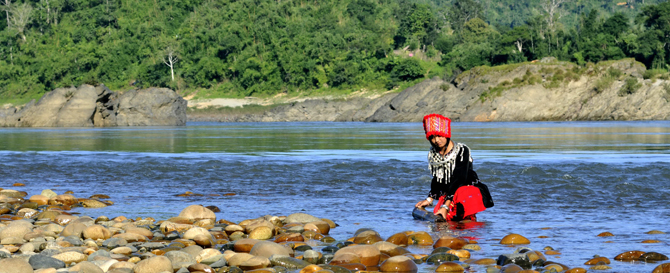Burma's Natural Resources Add Fuel to Conflict

BANGKOK—Burmese environmentalists say that the dozens of foreign investment projects linked to Burma's natural resources are a driving force behind a recent increase in fighting between the Burmese army and ethnic armed groups in Burma's borderlands close to China and Thailand.
Speaking at the launch of “Burma's Environment: People, Problems, Policies,” a new report from the Burma Environmental Working Group (BEWG), Naw La, a Kachin whose family has been driven from their home by fighting between the Burmese military and the Kachin Independence Army (KIA), said that fighting started after the Burmese government apparently did not listen to Kachin concerns about Chinese-backed hydropower dams in the northern region of Burma.
“The KIO (Kachin Independence Organisation, the political wing of the KIA) sent many letters to Naypyidaw and to the Chinese government, objecting to the Myitsone dam, and warning that there could be civil war if the dam is not stopped,” he said.
According to the Kachin Development Networking Group (KDNG), which contributed to the BEWG report, the proposed dam will force 15,000 people to leave their homes and flood about 766 km sq of land—an area larger than Singapore—where the Mali and N'Mai rivers meet to form the Irrawaddy, Burma's longest river.
“Most of the electricity will be sold to China with no benefit for locals,” said Naw La, who said that Kachin residents or representatives were not consulted about the project by the Burmese government or the main investors, China Power Investment Corporation and Asia World.
Around 16,000 people have been driven from their homes by the fighting since June 9, with Kachin exile groups in Thailand alleging that soldiers from the Burmese army gang-raped and in some cases murdered at least four women in Kachin State, and 18 others in Shan State to the south.
Both the KIA and the Burmese government blame each other for breaking the 1994 ceasefire, with the state-run The New Light of Myanmar (NLM) running numerous stories recently alleging the KIA shot first, while implying that government forces are intervening to protect the public and investment projects.
A July 6 NLM article accuses the Kachins of "committing mine explosions on motor roads, railroads and bridges for killing and wounding the people in Kachin State due to the fact that the Tatmadaw opened limited fires for the sake of project and public security.” [sic]
The Burmese army is said to be moving thousands of additional troops close to KIA headquarters, prompting fears that fighting will intensify.
All told, an estimated 48 hydropower projects are planned or are being built in Burma, 25 of which are mega-dams similar to Myitsone. These will cost around US $35 billion, will generate 40,000Mw of electricity, and will earn the Burmese government an estimated $4 billion in annual revenue.
Noting the proximity of many China-backed investments to the KIA, Maung Zarni, a Burmese UK-based academic and dissident, said, “The regime's military attacks against the KIA ... has absolutely nothing to do with the group's refusal to be subjugated in the form of the Border Guard Force. The Wa, and other similar ceasefire groups, have said 'No' to the regime on this as well—but everything to do with the Burmese regime pre-empting any security risks posed by the KIA to the Sino-Naypyidaw commercial project.”
Another major source of revenue for the Burmese government is oil and gas, with the country's rulers netting an estimated $4.6 billion earned from the Yadana gas project between 1998 and 2009. The Yadana pipeline was rife with controversy from the outset, with allegations of human rights abuses by the Burmese army, which was tasked with providing security for the pipeline, which runs through ethnic minority areas to Thailand.
The new Shwe Gas project is expected to earn the Burmese government $1 billion a year in revenues, over three decades, when it is ready in March 2013, with pipelines running though Shan and Kachin ethnic minority areas in Burma's north, en route to China's Yunnan Province.
The pipeline route is close to areas controlled by militias such as the KIA and factions of the Shan State Army opposed to the Burmese government's Border Guard Force plan. Since 2009, the then-military junta has demanded that the ethnic militias merge with the army and restrict their activities to border guard duties as permitted by the central government.
1 | 2 next page »
|
||
|
||
|
||
|
||
|
||
|
||
|
||
|
||
- 'My Wife Died From Police Abuse,' Says Husband
- US Says Observer Conditions Don't Meet Int'l Standards
- 159 Observers to Monitor Burma Election
- Govt to Address Breaches of SSA-South Ceasefire: Aung Min
- Burma Investors Pin Hopes on Seminal Sunday
- Malaysia PM Leads 50-Strong Delegation to Burma
- US Congress to Assess Burma's Political Prisoner Issue
- Rangoon Woman in Police Station Death Plunge
- Burmese Legal System Remains Tool of Govt: AHRC
- Burmese Army Chief Defends Political Role
